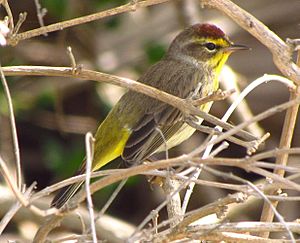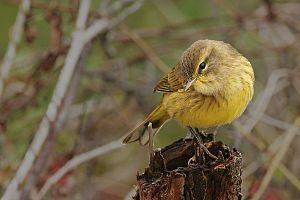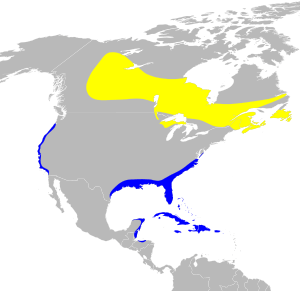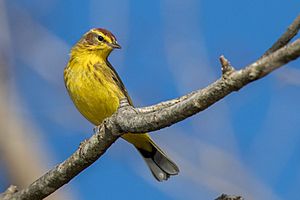Palm warbler facts for kids
Quick facts for kids Palm warbler |
|
|---|---|
 |
|
| "Brown" palm warbler in breeding plumage | |
 |
|
| "Yellow" palm warbler in non-breeding plumage | |
| Conservation status | |
| Scientific classification | |
| Genus: |
Setophaga
|
| Species: |
palmarum
|
 |
|
| Breeding range Wintering range | |
| Synonyms | |
|
Dendroica palmarum |
|
The palm warbler (Setophaga palmarum) is a small songbird from the New World warbler family. These active birds are known for constantly bobbing their tails. They live in North America, breeding in Canada and the northeastern United States. They then fly south for the winter.
Contents
What Palm Warblers Look Like
Palm warblers are small birds. They are about 12 to 14 centimeters (4.7 to 5.5 inches) long. They weigh between 7 and 13 grams (0.3 to 0.5 ounces). Their wings can spread out to about 20 to 21 centimeters (7.9 to 8.3 inches).
Types of Palm Warblers
There are two main types, or subspecies, of palm warblers. They look a bit different from each other.
One type is called the "yellow palm warbler" or "eastern palm warbler" (S. p. hypochrysea). These birds live in the eastern part of the breeding area. They have brownish-olive feathers on their backs. Their undersides are bright yellow with strong reddish-brown streaks on their chest and sides. They fly south for winter later than the other type.
The other type is the "brown palm warbler" or "western palm warbler" (S. p. palmarum). This type lives in the western two-thirds of the breeding area. They have less yellow on their undersides and lighter streaks. Their upper parts are a cool grayish-brown color.
Where Palm Warblers Live
Palm warblers build their nests in open bogs and forest edges. These areas are usually found east of the Continental Divide in Canada and the northeastern United States.
When winter comes, these birds migrate south. They fly to the southeastern United States, the Yucatán Peninsula, islands in the Caribbean, and eastern Nicaragua down to Panama. They are one of the first warblers to return to their breeding grounds in the spring. They often finish their migration almost two months before most other warblers.
Unlike many other Setophaga warblers, palm warblers spend winter along a large part of the Atlantic coast of North America. Some even go as far north as southern Nova Scotia. Since 1900, people have seen palm warblers in Massachusetts during the Christmas Bird Count. They have been seen regularly in Nova Scotia since 1958. Between 1966 and 2015, the number of palm warblers grew in most of their northern breeding areas.
Sometimes, a palm warbler has even been seen far away in Iceland. This is very rare and means it was a "vagrant" bird.
Palm Warbler Behavior
Palm warblers build their nests in the shape of an open cup. They usually place their nests on or very close to the ground in open spaces.
These birds spend a lot of time looking for food on the ground. They eat mostly insects and berries. Sometimes, they will fly up to catch insects in the air. A special thing about palm warblers is that they constantly bob their tails up and down. This is a great way to tell them apart from other birds. Only a few other warblers, like the Kirtland's and prairie warblers, also bob their tails all the time.
The song of the palm warbler is a simple, buzzing sound. Their call is a short, sharp "chek!" sound.
See also
 In Spanish: Reinita palmera para niños
In Spanish: Reinita palmera para niños




